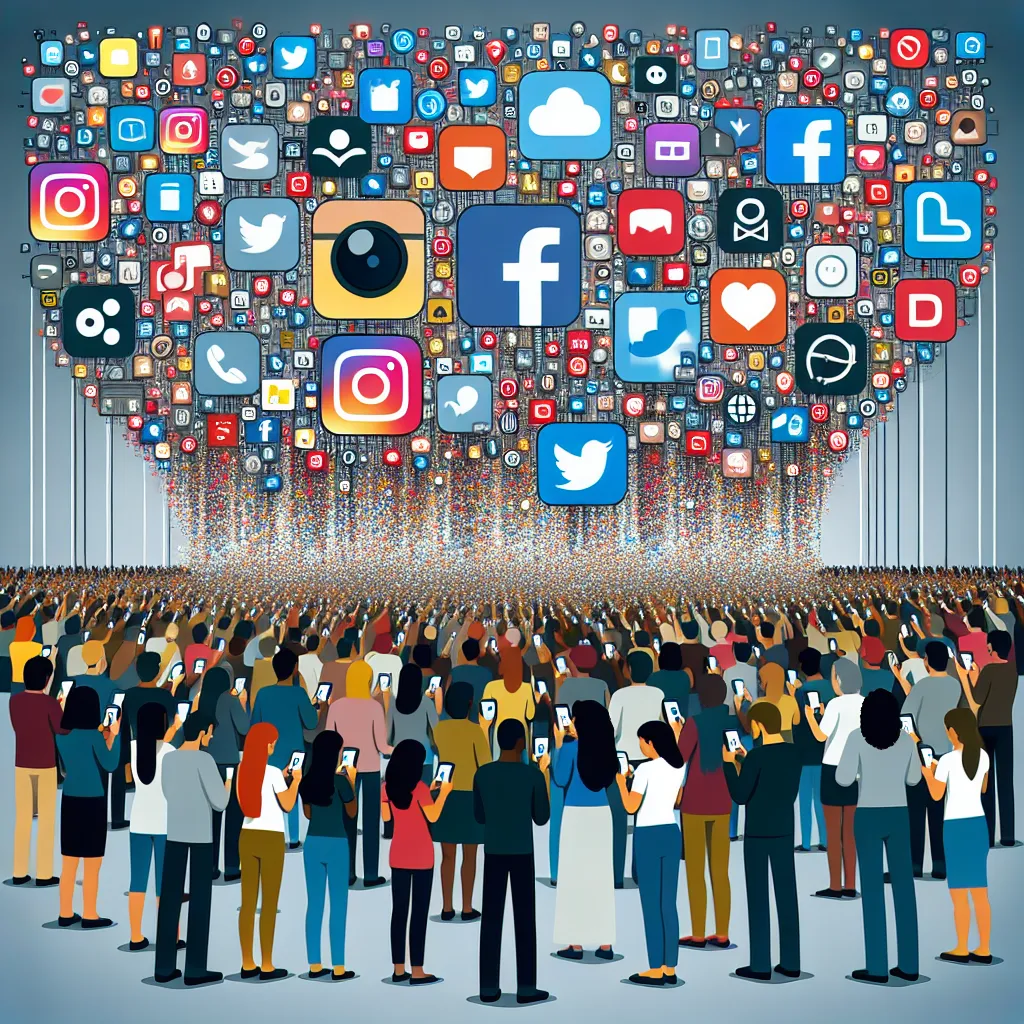The IELTS Reading section tests your ability to understand and analyze complex texts on various topics. One increasingly relevant subject that often appears in IELTS exams is the influence of social media on public opinion. This topic has gained significant traction in recent years due to the growing impact of digital platforms on our daily lives and societal discourse.
Based on the analysis of past IELTS exams and current trends, it’s highly likely that you’ll encounter passages related to social media’s role in shaping public opinion in future tests. The prevalence of this theme reflects its importance in contemporary society and its relevance to academic and professional contexts.
Let’s dive into a practice reading passage on this subject to help you prepare for your IELTS exam.
 Social media influencing public opinion
Social media influencing public opinion
Reading Passage
The Digital Shift in Public Discourse
Social media platforms have revolutionized the way information is disseminated and consumed, fundamentally altering the landscape of public opinion formation. Unlike traditional media, which often follows a top-down approach in information distribution, social media enables a more democratic and participatory environment where individuals can both consume and produce content. This shift has led to a decentralization of information sources and a diversification of voices in the public sphere.
The immediacy and accessibility of social media have accelerated the speed at which information spreads and opinions form. A tweet, Facebook post, or YouTube video can go viral within hours, reaching millions of users and potentially swaying public sentiment on important issues. This rapid dissemination of information has both positive and negative implications for public discourse.
On the positive side, social media has given voice to marginalized groups and facilitated grassroots movements. Campaigns like #MeToo and #BlackLivesMatter gained momentum through social media, bringing important social issues to the forefront of public consciousness. These platforms have enabled citizens to organize, mobilize, and effect change in ways that were previously challenging or impossible.
However, the same features that make social media a powerful tool for positive change also make it vulnerable to manipulation and misinformation. The ease with which content can be shared has led to the proliferation of “fake news” and conspiracy theories. Echo chambers and filter bubbles, created by algorithmic content curation, can reinforce existing beliefs and polarize opinions, making it difficult for users to encounter diverse viewpoints.
The role of social media influencers in shaping public opinion has also become increasingly significant. These individuals, who have amassed large followings on platforms like Instagram and TikTok, can sway their audiences’ opinions on various topics, from consumer products to political issues. The authenticity and relatability of influencers often make their messages more impactful than traditional advertising or political campaigning.
Moreover, the vast amount of data collected by social media platforms has enabled unprecedented targeting of content and advertisements. This micro-targeting allows political campaigns and interest groups to tailor their messages to specific demographics, potentially influencing voting behavior and policy preferences.
As social media continues to evolve, so too does its impact on public opinion formation. The challenge for society lies in harnessing the positive aspects of these platforms while mitigating their potential for manipulation and division. Education in digital literacy, transparent platform policies, and ethical use of data are crucial steps in ensuring that social media contributes positively to public discourse and democratic processes.
Questions
Multiple Choice
-
According to the passage, which of the following is NOT a characteristic of social media’s impact on public opinion formation?
A) Decentralization of information sources
B) Increased speed of information spread
C) Uniformity of viewpoints
D) Empowerment of marginalized voices -
The text suggests that social media has:
A) Replaced traditional media entirely
B) Only negative effects on public discourse
C) Both positive and negative implications for public opinion
D) No significant impact on political movements -
Which of the following is mentioned as a potential negative consequence of social media’s influence?
A) Increased voter turnout
B) Formation of echo chambers
C) Slower spread of information
D) Decreased political engagement
True/False/Not Given
- Social media has made it easier for grassroots movements to gain traction.
- Traditional media is more effective at spreading information quickly than social media.
- All content on social media is fact-checked before being shared.
- Social media influencers have no impact on political opinions.
Matching Headings
Match the following headings to the correct paragraphs in the passage:
A) The double-edged sword of rapid information spread
B) The rise of influencer impact
C) Transforming the information landscape
D) Data-driven opinion shaping
E) Challenges and future directions
- Paragraph 1 ___
- Paragraph 2 ___
- Paragraph 6 ___
- Paragraph 7 ___
Summary Completion
Complete the summary below using NO MORE THAN TWO WORDS from the passage for each answer.
Social media has transformed public discourse by creating a more (12) ____ and participatory environment for information sharing. While it has given voice to (13) ____ groups and facilitated important social movements, it has also led to the spread of (14) ____ and conspiracy theories. The creation of (15) ____ by algorithmic content curation can reinforce existing beliefs and polarize opinions. The challenge for society is to harness the positive aspects of social media while mitigating its potential for (16) ____ and division.
Answer Key and Explanations
-
C
Explanation: The passage states that social media has led to a “diversification of voices in the public sphere,” which is the opposite of uniformity of viewpoints. -
C
Explanation: The text explicitly mentions both positive and negative implications of social media on public discourse. -
B
Explanation: The passage mentions “Echo chambers and filter bubbles” as negative consequences of social media’s influence. -
True
Explanation: The text states, “These platforms have enabled citizens to organize, mobilize, and effect change in ways that were previously challenging or impossible.” -
False
Explanation: The passage indicates that social media has “accelerated the speed at which information spreads,” suggesting it is faster than traditional media. -
Not Given
Explanation: The passage does not provide information about fact-checking processes on social media. -
False
Explanation: The text states that influencers “can sway their audiences’ opinions on various topics, from consumer products to political issues.” -
C
-
A
-
B
-
E
-
democratic
-
marginalized
-
misinformation
-
echo chambers
-
manipulation
Common Mistakes
When tackling reading passages like this one, students often make the following mistakes:
-
Overlooking key phrases: Pay attention to words like “both,” “however,” and “moreover,” which often signal important contrasts or additional information.
-
Making assumptions: Avoid drawing conclusions not explicitly stated in the text. For example, the passage doesn’t state that traditional media is obsolete, only that social media has changed the landscape.
-
Misinterpreting True/False/Not Given questions: Remember, “Not Given” means the information is neither confirmed nor denied by the passage.
-
Rushing through the text: Take time to understand the overall structure and main ideas before attempting to answer questions.
Vocabulary
- Disseminated (verb): Spread or disperse widely
- Decentralization (noun): The transfer of control from one central authority to several local authorities
- Marginalized (adjective): Treated as insignificant or peripheral
- Grassroots (adjective): Of or involving the common people, especially as contrasted with the leadership of a movement
- Proliferation (noun): Rapid increase in numbers
- Echo chambers (noun): Environments where a person encounters only beliefs or opinions that coincide with their own
- Filter bubbles (noun): A state of intellectual isolation that can result from personalized searches when a website algorithm selectively guesses what information a user would like to see
Grammar Focus
Pay attention to the use of present perfect tense in the passage, such as:
“Social media platforms have revolutionized the way information is disseminated and consumed.”
This tense is used to describe actions that started in the past and continue to have relevance in the present. It’s formed using “have/has” + past participle.
Example: Social media has given voice to marginalized groups.
Practice using this tense to discuss ongoing changes or developments in various fields.
Tips for IELTS Reading Success
-
Time management is crucial. Allocate your time wisely between reading the passage and answering questions.
-
Skim the passage first to get a general idea, then read more carefully.
-
For Multiple Choice questions, eliminate obviously incorrect options to increase your chances of selecting the correct answer.
-
In True/False/Not Given questions, be careful not to bring in outside knowledge. Base your answers solely on the information provided in the passage.
-
For Matching Headings, look for key ideas in each paragraph that align with the given headings.
-
In Summary Completion tasks, pay attention to word limits and ensure your answers fit grammatically into the sentence.
-
Build your vocabulary related to current affairs and technology, as these topics are increasingly common in IELTS Reading tests.
-
Practice regularly with diverse texts to improve your reading speed and comprehension.
Remember, success in IELTS Reading comes from a combination of strong language skills, effective strategies, and familiarity with various question types. Keep practicing, and you’ll see improvement in your performance.
For more practice on related topics, check out our articles on how social media influences the perception of environmental issues and the effects of social media on public opinion during elections. These resources will help you further understand the complex relationship between social media and public opinion, a topic that’s likely to appear in future IELTS exams.


